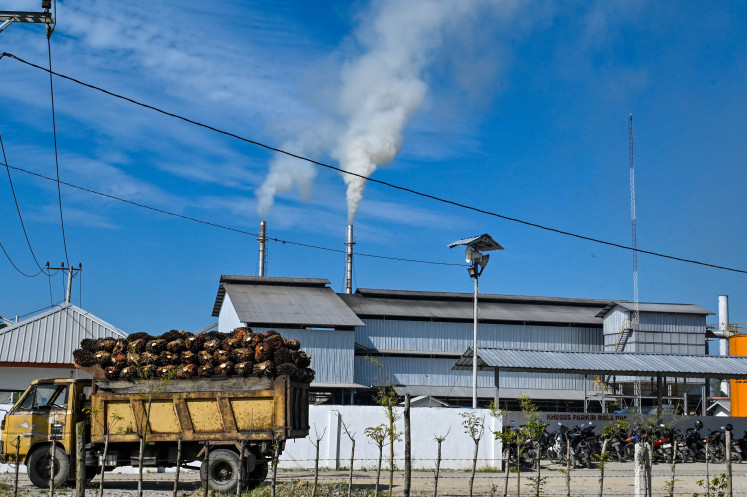Popular Reads
Top Results
Can't find what you're looking for?
View all search resultsPopular Reads
Top Results
Can't find what you're looking for?
View all search resultsRecognition of customary forests yet to help indigenous peoples
On May 16, 2012, the Constitutional Court restored the rights of indigenous peoples over customary forests
Change text size
Gift Premium Articles
to Anyone
O
n May 16, 2012, the Constitutional Court restored the rights of indigenous peoples over customary forests. This decision has had wide implications. It is a correction to the decades of state domination over customary forests belonging to indigenous peoples. With that decision, the Constitutional Court reconfirmed that the indigenous peoples are the rightful owners that hold the capacity to execute legal actions and thus can be legally held responsible for their actions.
Now, years after the ruling, customary forests are supposedly no longer part of state forests. But can indigenous peoples and the nation really celebrate the restitution of indigenous peoples’ right over their land? While some progress has taken shape, the struggle is not over yet.
Under the New Order, human rights abuses were rampant against indigenous peoples. The 1967 Basic Forestry Law was used to forcefully acquire customary forests. Unfortunately, more than 20 years after the New Order regime fell, agrarian conflicts stemming from this capitalistic process is still around us.
Some of the cases became important parts of Indonesian modern history, particularly the history of Indonesia’s human rights movements. Examples are the conflicts of the Haruku peoples against Ingold in Central Maluku, the Dayak Benuaq and Tunjung peoples versus Kelian Equatorial Mining in East Kalimantan, dozens of Batak Toba peoples of North Sumatra who opposed the tree plantation company PT Inti Indorayon Utama, the Amungme and Kamoro peoples against Freeport McMoran Indonesia in Papua and many more.
After the New Order ended, several Indonesian indigenous leaders and activists approached me in 1998. They raised the need to organize an indigenous community’s congress and they requested me to chair the congress’ organizing committee.
The congress was needed to establish better coordination among indigenous peoples in advocating their rights. The first Indonesian Indigenous peoples Congress was eventually held in 1999. The congress saw a historic moment with the establishment of the Indigenous Peoples Alliance of the Archipelago (AMAN). The organization currently represents 2,332 indigenous peoples throughout Indonesia and has become well respected nationally and by the international community as well.
Now, 20 years after a nationwide indigenous peoples organization was established and seven years after the Constitutional Court ruling, the rights of the indigenous peoples are not yet fully protected and fulfilled.
Although President Joko “Jokowi” Widodo himself acknowledged the existence and rights of indigenous peoples in his Nawacita campaign document in 2014, conflicts involving indigenous peoples have still resulted in human rights violations. So what went wrong?
Over six decades ago the Constitution of the new republic had already acknowledged the existence of the indigenous peoples. The elucidation of the original Article 18 of the 1945 Constitution clearly stated that the lowest level of autonomy of the nation lies within the villages and the kampung. It refers to indigenous governing structures that should be recognized and respected by the state, based on the “right of origin”.
Following the 2012 Constitutional Court ruling, efforts to acknowledge and protect the indigenous peoples became stronger. The ruling was followed by intensified advocacy by the government, indigenous peoples, indigenous community organizations and NGOs to bolster recognition of indigenous peoples, customary land and customary forests. In 2014, the National Commission on Human Rights (Komnas HAM) utilized the above Constitutional Court Ruling No. 35 its national inquiry into the violations of human rights in forest areas.
The Inquiry reviewed hundreds of cases of contested land claims in forest areas that involved indigenous peoples. Forty of them were selected for further study, heard at public hearings in seven regions and once at the national level. Of the 40 cases, Komnas HAM recommended the government prioritize law enforcement efforts for companies including revocation of permits in seven cases, and recommendations for priority mediation between companies and indigenous peoples in six cases. The other cases required more comprehensive efforts. Unfortunately only few cases were resolved.
It is important for us as a civilized nation to restore indigenous peoples’ rights, not on a case-by-case basis. We can learn from the process of rights restitution in other countries such as South Africa. After the apartheid regime fell they established the Commission on Restitution of Land Rights. The commission was assigned within a certain period to restore the land rights of the indigenous peoples based on claims by a person or a community dispossessed of their rights to land after June 19, 1913, as a result of past racially discriminatory laws or practices.
We can apply a similar principle and enrich it with Indonesian values. That way, we can systematically solve the root problems and provide remedies for the violation of human rights of the indigenous peoples, which would eventually contribute to their well-being.
_______________________
The writer is deputy of external affairs and a commissioner of the National Commission on Human Rights.










